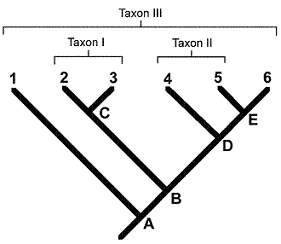What evolutionary advances are demonstrated in the nervous systems of bilaterally symmetrical
animals? What will be an ideal response?
Concepts to Consider: 1) increased number of nerve cells; 2) nerve cells become concentrated in
masses, such as ganglia and brains; 3) specialization of function--requires afferent and efferent nerves
and effectors; 4) more complex synaptic contacts and association neurons--allows greater precision
and integration of messages; 5) cephalization--concentration of sense organs at front end allows more
rapid response to predators or prey.
You might also like to view...
The variable region of an antibody occurs
A. only on the heavy chains. B. only on the light chains. C. on one of the light chains. D. on all four chains.
The embryo is within the structure indicated by
a. A. b. B. c. C. d. D. e. E.
In Figure 23-2, the pair of organisms that have the most recent ancestor is:
a. 2 and 4.
b. 6 and 4.
c. 4 and 5.
d. 2 and 3.
e. 1 and 2.
T or F: Muscles shorten by 50% to 70% of their resting length
What will be an ideal response?